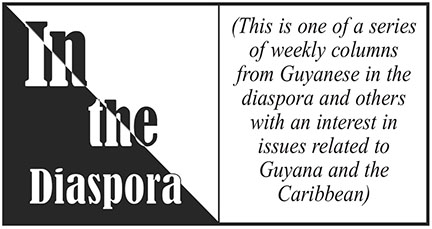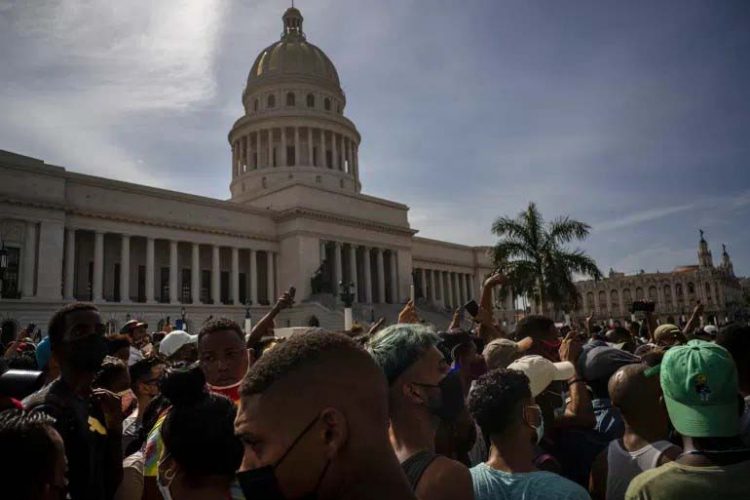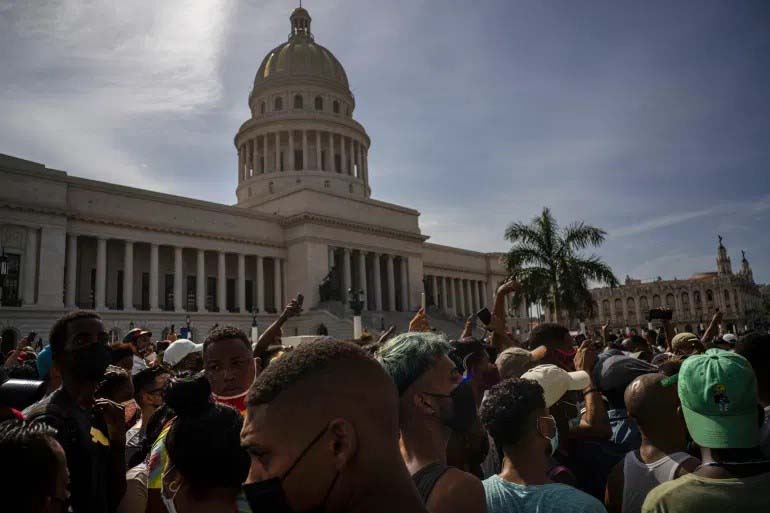By Karen Dubinsky and Susan Lord
Karen Dubinsky and Susan Lord teach at Queen’s University in Kingston, Ontario, where they teach and coordinate a Cuban cultural exchange program.
Time is a funny thing in Cuba. As the ethnographer Fernando Ortiz noted in 1940, “the whole gamut of culture run by Europe in a span of more than four millenniums took place in Cuba in less than four centuries.” And yet, in daily life, especially in the last decades, time can seem immoveable. The dramatic protests of Sunday 11 July, which took place in some 30 cities and towns across the country, seemed to appear by surprise, although the immediate triggers were obvious: escalating COVID rates (despite tremendous success by the Cubans in vaccination development), an economy in freefall, thanks to both COVID and the devastating effects of the embargo that was tightened under the Donald Trump administration and included designation of Cuba as a state sponsor of terrorism, state attempts at currency regulation and subsequent rectifications which have exacerbated racialized economic inequalities, food lineups evoking the worst days of the 1990s post-Soviet era, and continued suppression of civil protest. As always, Cuban artists have been quick to voice their frustrations in public, which itself has led recently to renewed censorship battles. Political conflict is nothing new, but taking these criticisms to the street, chanting “libertad” and, at the police “asesinos,” that’s next level in Cuba. When things move, they can move at a revolutionary pace.


Cuban commentators have noted how unprecedented this rolling protest was. It didn’t start in Havana; while a majority are younger, it was multigenerational; it was primarily black. There are moments of civil action in the recent past that give us some measure of how distinct this moment is. A protest known as the “Maleconazo” took place in 1994 against policies and scarcity in the worst moment of the Special period. It was largely localized in Havana; it resulted in a massive emigration. Since then, a lot has changed. The 1990s saw the re-emergence of a black public sphere not seen since the 1960s, wherein institutions such as Color Cubano set about addressing racism. The struggle for queer rights found an institutional home, a pride parade (occasionally censored) and an uneven uptake on rights and policy. And, finally, there has been a recent series of confrontations around artists’ rights where artists have been detained. All of this has been covered on social media and by an emerging sector of independent journalists. These public examples tell us about a growing, complex relationship to Cubanness; there is plenty of space between “revolutionary” (loyalist) and “gusano” (opponent). The characterization of the protestors as criminals or dupes of imperialism ignores decades of debate and change that have been taking place in Cuban civil society.
The dire health and economic situation facing Cuba now is on par with much of the rest of the region. Yet we too echo Leo Brouwer that this moment is a hard one to imagine. The US has been committed to destabilizing the country since the Revolution and continues to do so, in the midst of the devastating and uneven effects of a worldwide pandemic. Resisting these forms of imperial intervention, claiming independence and supporting other nations in their claims, making a place of safety for those fleeing violence, and bringing a people to dignity, literacy and health: this is why Cuba has inspired so many for years. We teach a university course in Canada that brings students to the University of Havana. For over a decade we have watched our students learn from Cuban professors, artists, and musicians, and absorb many of the contradictions that make up contemporary Cuba. They learn that dignity and literacy strengthen a resolve to contribute. But that contribution is not a mirror of the state, is not a script: the contribution is nuanced and critical of power, corruption, and hypocrisy. It is generous, it creates, it seeks peace.
In the contact we’ve had with Cuban friends and colleagues inside and outside Cuba since the protests, sorrow stands out as the prevailing emotion — sorrow over their neighbour’s called to become each other’s enemies, over fear for their kids who went out to protest, over this being the outcome of decades of sacrifice. And behind the sorrow is also exhaustion in the struggle for basics, the fear of more illness without medicine, of houses collapsing. For its part, the time is well past due for the US and the international community to respond with a hand of genuine humanitarianism, with the end of the embargo. For the Cuban government’s part, we return to Julio César Guanche: “The only question now is: what will the new day bring? We know that there are certainties and duties of the ‘Revolution’s defense’: the population is a plural construct and is never the enemy, and the promise made in 1959 was ‘Freedom with bread, and bread without terror’.”






